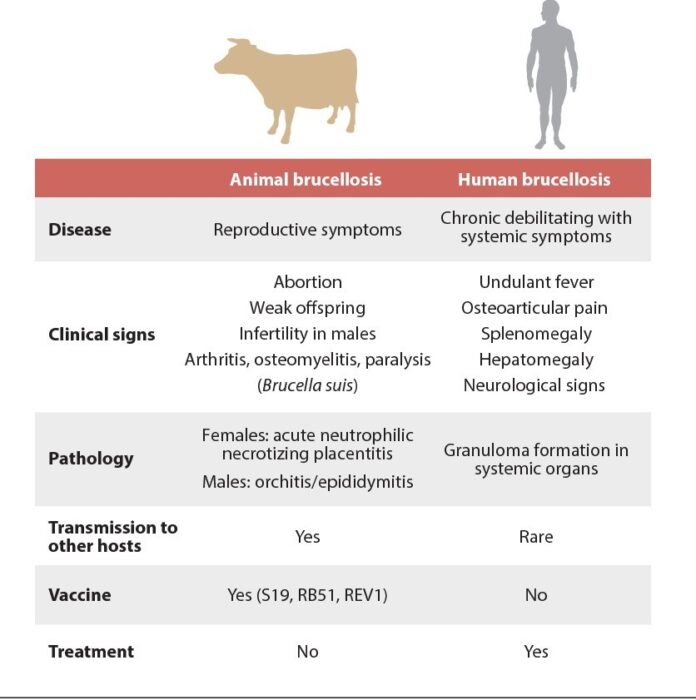Brucellosis – A zoonotic diseases in Swine
Jai Bhagwan1, Mahavir Chaudhari2, Hardeep Kalkal3
1Assistant Professor, 2 Extension Specialist, Pashu Vigyan Kendra, Sirsa, Lala Lajpat Rai University of Veterinary and Animal Sciences, Hisar, 3 Extension Specialist, Krishi Vigyan Kendra, Sirsa (CCS HAU Hisar)
Brucella suis is a significant zoonotic species that is present in domestic livestock and wildlife in many countries worldwide. Transmission from animal reservoirs is the source of human infection as human-to-human transmission is very rare. Although swine brucellosis causes economic losses in domestic livestock, preventing human infection is the primary reason for its emphasis in disease control programs. Although disease prevalence varies worldwide, in areas outside of Europe, swine brucellosis is predominantly caused by B. suis biovars 1 and 3. In Europe, swine are predominantly infected with biovar 2 which is much less pathogenic in humans. In many areas worldwide, feral or wild populations of swine are important reservoir hosts.
Brucellosis in swine, a disease caused by infection with intracellular bacteria from the genus Brucella, is a disease of economic importance with worldwide distribution. Although the disease is associated with reproductive losses in swine worldwide, its primary importance is related to its zoonotic capability of causing clinical symptoms in humans. For this reason, many countries have regulatory programs to address swine brucellosis. Several studies have indicated that addressing brucellosis in livestock reservoirs is the most efficient and economical approach for reducing human brucellosis.
Like other Brucella spp. in their natural host, B. suis has developed mechanisms to survive in an intracellular environment and evade immune detection. Limitations in sensitivity and specificity of current diagnostics require use at a herd level, rather for individual animals. There is currently no commercial vaccine approved for preventing brucellosis in swine. Although not feasible in all situations, whole-herd depopulation is the most effective regulatory mechanism to control swine brucellosis.
Transmission of Diseases
Brucella suis is transmitted mainly via ingestion of infected tissues or fluids. Infected boars may transmit the disease during service; the organism can be recovered from semen. In the many countries, feral swine are the primary source of transmission for B suis. Brucellosis due to Brucella suis may occur in domestic animals other than pigs. Brucellosis in humans has been reported among packing-house workers and hunters; the usual source is infected pigs.
Clinical finding
Clinical signs of brucellosis in pigs vary but are similar to those in cattle and goats. Although the disease is often self-limiting, it remains in some herds for years.
After exposure to Brucella suis, pigs develop a bacteremia that may persist for up to 90 days and continue shedding for up to 3 years. During and after the bacteremia, localization typically occurs in lymphatics, spleen, liver, and mammary and reproductive tissues. Clinical signs depend considerably on the site(s) of bacterial colonization and commonly include:
- Temporary or permanent sterility
- Orchitis
- Abortion
- Lameness
- Hindlimb paralysis
- Spondylitis
- Metritis and abscess formation (occasionally)
The incidence of abortion may range from 0% to 80%. Abortions may also occur early in gestation and be undetected. Usually, sows or gilts that abort early in gestation return to estrus soon afterward and are rebred.
Infection early in pregnancy commonly results in reproductive failure, including decreased litter size, abortion, stillbirth, and birth of weak piglets. Infertility in sows, gilts, and boars is common and may be the only clinical sign of brucellosis. Before attempting treatment for other diseases, it is logical to test for brucellosis in herds in which sterility is a problem.
Infertility in sows is usually temporary but may be permanent. In boars, orchitis, usually unilateral, may occur, and fertility appears to decrease.
Diagnosis
- Serologic testing
- Herd status
The principal means of diagnosis in pigs is serologic testing, such as the brucellosis card (rose bengal) test, other serum agglutination tests, or complement fixation tests. These tests are used in series to confirm seropositivity.
It is generally accepted that the tests have limitations in detecting brucellosis in individual pigs. Thus, entire herds or units of herds, rather than individual pigs, must be tested in any control program. Low agglutinin titers occur in almost any size herd, regardless of infection status, and a few infected pigs may have no detectable titer. Cross-reactions with other pathogens, such as Yersinia enterocolitica, have been reported. The card test is usually more sensitive than other agglutination tests. Supplemental tests designed for cattle may also be used for pigs.



